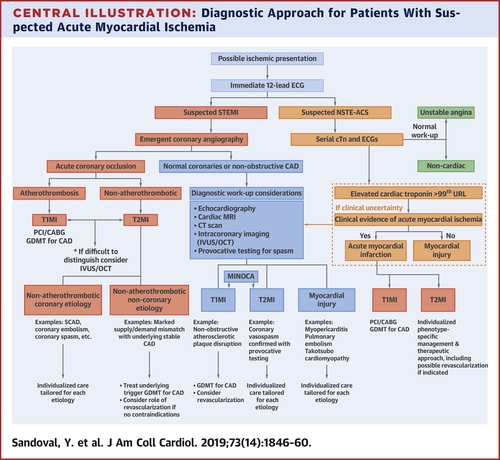Chest Pain Approach to Chest Pain Classifying Angina Angina Pectoris: Chest pain due to >70% stenosis Classic/Cardiac (Typical Angina): All 3 of the following 1) Typical location (substernal), quality (dull), and duration Quality: Squeezing, tightness, pressure, constriction, fullness, heaviness, and weight Clenches fist over mid-sternal area Often radiates to the left shoulder, neck, or arm Builds in intensity over a few minutes (2-30mins) <2 mins: not MI 2-5 minutes: Stable angina more than 30mins: MI 2) Provoked by exercise or emotional stress 3) Relieved by rest or nitroglycerin Atypical Angina (Possibly Cardiac): only 2 of the 3 above Non-anginal: <2 of the 3 above Pulmonary/Pleuritic Chest Pain (pleurisy, pneumonia, pericarditis, PE) Sharp/stabbing pain, worse with inspiration Pericarditis is worse when lying flat, breathing No chest wall pain TTE to assess for pericardial effusion Pneumothoraxes have respiratory distress/hypoxia/tachycardia Pleuritic chest pain and or dyspnea Peripheral or apical radiolucency, absence of lung markings beyond the lung edge PE Sudden onset dyspnea and pleuritic chest pain Tachypnea, tachycardia, cough, hemoptysis ± LE swelling CXR: atelectasis, infiltrates, pleural effusions, Westermark’s Sign (peripheral hyperlucency due to oligemia) Viral Pleurisy: inflammation of the lung pleura that presents with fever and pleuritic chest pain Pleural friction rib may be present (disappears with breath holding, pericardial friction rub does not) ESR elevated in SLE Pleuritis, Not tenderness to palpation CXR/Chest CT Aortic (dissection, intramural hematoma) Sudden, severe tearing pain, radiates to back, elderly, hypertension/atherosclerosis, tachycardia Irregular aortic contour with inward displacement of atherosclerotic calcification No tenderness to palpation Chest CT GI Disease (Spasm/GERD/Ulcer) Esophageal Spasm 5-60 minutes Visceral, spontaneous, substernal, associated with cold liquids, relief with nitro Gastric Esophageal Reflux Disease (GERD) 5-60 minutes Non-pleuritic, Non-exertional/no pain with movement, worse with recumbency, visceral/burning, relieved by antacids or food, cough, hoarseness due to aspiration, upper abdominal/substernal, associated with regurgitation, nausea, dysphagia, nocturnal pain, non-radiating Reflux may improve with siting up Endoscope ± pH testing Chest wall/Musculoskeletal (MSK) chest pain Persistent and or prolonged pain, worse with movement or position change, often follows repetitive activity Costochondritis Most common cause of MSK chest pain RF: Strenuous exercise, joint aggravation (weightlifting) Sharp, localized chest pain that worsens with inspiration/movement/coughing and tender to palpation of ≥1 anterior chondral joint Either costochondral or sternochondral joints No swelling, no tachycardia/bradycardia Usually benign and self-limiting and resolves in weeks, but may last >1 year Normal EKG and CXR Treatment Reassurance and symptomatic pain management Differential Rule out the scary things 1st : MI PE Esophageal Rupture Aortic Dissection Pneumothorax Work-up EKG Best test is EKG followed by Cardiac Enzymes every 8 hours (3 sets needed) Nonischemic ECG and negative biomarkers at 0 hr and 3 hr reduces risk of MACE to less than 1% Used to rule in or rule out STEMI graph LR
A[EKG] --> B{STEMI?};
B -->|Yes| C[PCI!];
B -->|No| E[Elevated Trops?];
E -->|Yes| F[T2MI/NSTEMI];
F --> G[Risk Stratify]
G --> H[High Risk*?]
H -->|Yes| C;
H -->|No| I[TIMI/GRACE Scores];
E -->|No| J[Unstable Angina/Non-Cardiac CP];
J --> K[HEART Score];
K -->|Otherwise| G;
K -->|ACS <2% by clinical eval or HEART 0| L[Discharge];Troponin Causes of Troponin Elevation not related to Acute MI Other causes of myocardial injury Cardiac Heart Failure Myocarditis Cardiomyopathy of any type Takotsubo Syndrome Cardiac Contusion Systemic Sepsis CKD Stroke, subarachnoid hemorrhage PE, PHTN Infiltrative Disease Chemotherapy Critical illness Strenuous exercise Myocardial injury related to acute myocardial ischemia because of oxygen supply/demand imbalance Reduced myocardial perfusion Coronary Spasm Coronary Embolism, Coronary Artery Dissection Sustained Bradyarrhythmia Hypotension or Shock Respiratory Failure Severe Anemia Increased myocardial demand Tachycardia Severe HTN w/ + w/o LVH
Risk Stratification Pretest probability of coronary artery disease Low (<10%): Asymptomatic people of all ages Atypical chest pain in women age <50 Intermediate (20-80%): Atypical Angina in men of all ages Atypical Angina in women ≥50 Typical Angina in women 30-50 High (>90%): Typical Angina in men ≥40 Typical Angina in women ≥60 Diagnostics Low Risk No additional testing needed Intermediate Risk Noninvasive evaluation with exercise or pharmacologic stress testing High Risk Coronary Angiography vs. Stress Testing Start pharmacologic therapy for CAD (aspirin) HEART vs. TIMI vs. GRACE Predicts 6-week risk of major adverse cardiac event Do not use if new ST-segment elevation ≥1 mm or other new EKG changes, hypotension, life expectancy less than 1 year, or noncardiac medical/surgical/psychiatric illness determined by the provider to require admission ACS Chest Pain 